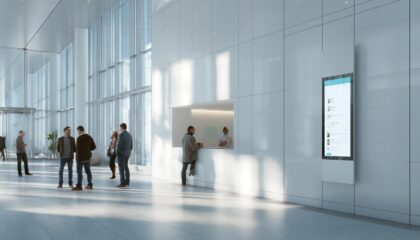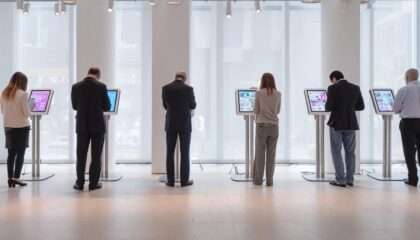Rental solutions for companies
How do VR glasses work with a smartphone – and what should companies consider when renting them?
How do VR glasses work with a smartphone?
Virtual reality (VR) is no longer just a promise for the future. VR technology is already being used successfully in numerous areas such as entertainment, training, marketing and industry. The variant with smartphones is particularly interesting: it enables a simple and cost-effective entry into the virtual world. But how exactly do VR glasses with a smartphone work? In this article, we explain the technology behind it, show current possible applications and provide an overview of different devices. You will also find out how your company can benefit from this technology – perhaps even by renting mobile devices such as smartphones for your next presentation or trade fair.
The basics of smartphone VR technology
VR glasses with a smartphone use the mobile device as a screen and computing unit. This means that, unlike high-end VR systems such as Oculus Rift or HTC Vive, smartphone VR glasses do not require their own hardware, but only a holder with lenses and, if necessary, controls.
The holder, also known as a “headset”, is usually made of plastic or cardboard (e.g. Google Cardboard) and contains two special lenses that divide the smartphone display into two areas – one for the left and one for the right eye. This creates a stereoscopic 3D effect for the wearer, which enables the typical “immersion” in virtual reality.
How the display works
- The smartphone is inserted horizontally into the headset.
- A special app or VR-compatible content is launched.
- The display shows two slightly offset images: one for the left eye and one for the right eye.
- The lenses in the headset shift these images to create a spatial 3D impression.
- The gyroscope and accelerometer in the smartphone detect head movements, which changes the image section.
This creates an immersive experience, even though the smartphone actually only has a flat display.
What technology is in smartphone VR glasses?
The following components are crucial for the VR experience with the smartphone:
| Component | Function |
|---|---|
| Smartphone display | Displays the image in two halves for each eye separately |
| Lenses in the headset | Bend the image so that it appears spatial |
| Gyroscope & sensors | Detect movements of the head to control the viewing direction |
| VR apps and content | Games, 360° videos or interactive content in split-screen mode |
Known models and platforms
The market has changed significantly in recent years. While Google Cardboard offered a low-cost introduction, manufacturers such as Samsung, Zeiss, Merge and others are now following suit. Below you can see an overview of well-known models that you can rent flexibly on request:
| Model | manufacturer | Special features |
|---|---|---|
| Google Daydream View | Soft, comfortable fabric cover, integrated controller | |
| Samsung Gear VR | Samsung | Optimum compatibility with Samsung smartphones, integrated control via controller |
| Zeiss VR One Plus | Zeiss | High-quality lenses, universally compatible, elegant and stable design |
Possible applications in a business context
VR offers numerous advantages for companies in particular. The affordable entry-level option with smartphone VR glasses makes it particularly interesting for B2B areas:
- Trade fair & event: Present products or work processes impressively in 3D.
- Training & further education: VR simulations enable realistic training without risk.
- Marketing: Inspire your customers with immersive storytelling experiences.
- Recruiting: Present company values and working environments in a tangible way.
If you want to experiment with such solutions, renting the appropriate technology – such as VR glasses and suitable smartphones – is an excellent way to implement them flexibly and cost-effectively.
Why rental instead of purchase?
Companies that want to use VR temporarily as an event solution, at trade fairs or for training benefit greatly from the rental model:
- No high investment costs
- Always the latest technology
- Scalable solutions for small and large events
- Support, transportation and configuration are included in many cases
Our B2B rental service offers a wide range of the latest VR glasses and compatible smartphones – including advice, accessories and on-site service.
Conclusion – VR with smartphone: entering the digital future
Smartphone VR technology is a fascinating way to discover virtual reality without major investment. Particularly in the B2B environment, it opens up new avenues for innovative presentations, interactive training and impressive marketing campaigns.
If you would like to use VR on a temporary or project-related basis, we recommend our mobile device rental service: you receive the latest technology, advice and support from a single source – tailored precisely to your event or project.
Are you interested? Then contact us directly and get a personalized quote for VR glasses and smartphones for rental. Your digital world of experience awaits!
Read more - You may also be interested in
Would you like to delve deeper into the topic or discover similar content? Below, we have compiled three additional articles for you that are thematically related to this article. These may also be relevant and interesting for your company.







